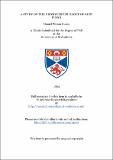Files in this item
A study on the Uromyces Pisi group of rust fungi
Item metadata
| dc.contributor.advisor | Macdonald, James Alexander | |
| dc.contributor.author | Burns, Daniel Wilson | |
| dc.coverage.spatial | 166 p. | en_US |
| dc.date.accessioned | 2018-06-19T14:31:08Z | |
| dc.date.available | 2018-06-19T14:31:08Z | |
| dc.date.issued | 1954 | |
| dc.identifier.uri | https://hdl.handle.net/10023/14272 | |
| dc.description.abstract | 1. The difficulties in separating the individual members of the Uromyces pisi group are outlined. 2. A review of the literature on rust fungi is given in which it is brought out that the major criteria for delimiting the species are (i) dimensions, wall thickness, number of germ pores and their distribution, for uredospores, (ii) dimensions, thickness of wall and pore cap, and wall sculpturing of the teleutospores, (iii) host specialisation, and (iv) length of life cycle. 3, 76 herbarium specimens along with the locally occurring member of the U. pisi group were examined from these stand-points, and the relative desoxy-ribose nucleic acid (D.F. A) content per nucleus of U. pisi. U. punctatus and U. loti was determined. 4. It was found that the species of the group could be separated by statistically analysing the spore measurements. Only U. jordianus could be separated by the number of germ pores of its uredospores, and both spore types of all the Species had approximately the same wall thickness. It is shown that the sculpturing of the teleutospore wall varies within each species and shows a gradation from a weakly punctate, to a definitely punctate-striate condition. A review of the literature on host specialisation and life cycle is given for each species, and a host list and synonym list has been compiled for each. From this review it is pointed out that, (1) it is difficult to separate certain of the species of the U. pisi group by host reaction and (ii) biological races exist in some of the heteroecious species. 6. Inoculation experiments were carried out with the locally occurring U. punctatue on Astragalus danicus, and it was found that the rust could infect 9 other species of Astragalus and one of Medicago. Attempts to geminate the teleutospores by various chemical stimulants failed with the exception of one teleutospore. Observation and experiment showed that U. punctatus could overwinter by means of uredospores. Inoculation experiments were carried out on the aecidial host, but no infection ensued after four years. It is concluded that U.punetatus at St, Andrew has lost the ability to infect the aecidial host and that this is due to, (i) the absence of the aecidia host over a period of years leading to adaptation to the uredo host, and (ii) various climatic factors. 7. Inoculation experiments carried out with the local specimens of U. pisi on Lathyrus pratensis and U. loti on Lotus corniculatus, showed that these rusts were narrowly specialised on their resptective hosts. Other closely related rusts which exist in the Hemi- form and are highly specialised with regard to host selection, are described and it is suggested that these rusts have probably arisen from specialised races of the heteroecious members of the group. 9. The ecology and geographical distribution of the group is discussed. The number of leguminous rusts in Britain is less than the number on the Continent. With the exception of U. pisi, heteroecism in the group is confined to Central and S. Europe. Outside this region the heteroecious species adopt the Hemi- form, and can overwinter in the uredo stage. In this condition they 'become more specialised. The number of possible British hosts is greater than the actual number parasitised, except. U. loti and U. laburni where the actual numbers are the same as the possible numbers of hosts. In considering these points it is suggested that the absence of the aecidial hosts from the region outside central S. Europe, has led to the species adopting the Hemi-form and becoming more specialised. Also in this region the climate is not favourable to the development of the aecidium. 10. It is suggested on this evidence, that the members of the group probably have a common ancestor. | en_US |
| dc.language.iso | en | en_US |
| dc.publisher | University of St Andrews | |
| dc.subject.lcc | QK627.U8B8 | en |
| dc.subject.lcsh | Rust fungi | en |
| dc.title | A study on the Uromyces Pisi group of rust fungi | en_US |
| dc.type | Thesis | en_US |
| dc.type.qualificationlevel | Doctoral | en_US |
| dc.type.qualificationname | PhD Doctor of Philosophy | en_US |
| dc.publisher.institution | The University of St Andrews | en_US |
This item appears in the following Collection(s)
Items in the St Andrews Research Repository are protected by copyright, with all rights reserved, unless otherwise indicated.

